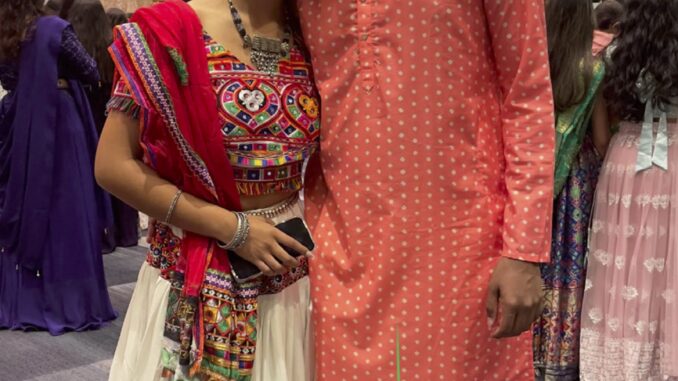
photo credit: Samira Kandarahi
Someone new to the Hindu culture and traditions walks into the Columbus Convention Center on Oct. 5 and was immediately thrown into an environment of fun and dancing with friends and family for nine days. This celebration lasts throughout the night, celebrates fertility and womanhood and is otherwise known as the Garba and Dandiya Festival.
Garba is a type of dance that originated in Gujarat, India. It is a form of dancing that is also a religious and social event.
“The part I enjoy most about Garba is feeling in sync with the music and expressing my happiness through dancing,” senior Aarav Gala said. Gala has been participating in Garba for “10 years.”
Garba can be done alone or with others, but it is typically done with family.
“The joy of Garba is very different for my family compared to when I was growing up. But when I do get a chance to go, it’s so much fun,” Mother of senior Anya Patel, Hema Patel said.
Garba is performed in a circle while wearing special outfits. Women typically wear colorful dresses.
“Our main family tradition is that we get together with our extended family in Columbus, go with them and we all dance in our own circle,” Gala said.
Garba is the largest and longest dancing festival in the world. It is performed during Navratri, literally meaning ‘nine nights’, and it is the Hindu festival dedicated to Durga – the feminine form of divinity and her nine forms, according to artidea.org. For some, Garba can be very family-oriented. Many traditions can be passed down from previous generations.
“When I was young, traditions were kept intact by my mom and my aunts. We followed what they would do, and looking back, we learned so much by attending Garba every year,” Patel said.
The actual dance can be performed in different styles. Some examples of these dances are Garba, Dandiya, Bhavi and Timpani. “One of the highlights of the festivals is dancing Garba, a traditional folk dance. There are different styles, some involve two sticks called dandiyas, and others are performed without them,” Mother of Aarav Gala, Chhaya Gala said.
There are also festivals and competitions for Garba. They can be found across the world, not just in India.
“Columbus does a good job organizing Garba. Now, there are thousands of people attending, so it’s not as intimate. I really don’t know many people so it’s always harder to get motivated to go,” Patel said.
The most traditional dance is “usually performed in a circle, with a lamp and an image of Goddess Durga at the center, symbolizing the cycle of life, birth and rebirth. The footwork is simple but high energy, with forward and backward steps coordinated with hand movements,” Chhaya said.
Garba in the United States is more laid-back compared to in India. In India, it takes place over nine full days, whereas in Ohio it sometimes only takes place on weekends or other days.
“Now that I live in Ohio, our family typically goes for Garba only on weekends, whereas in India, Navratri celebrations last for nine full days. Although it’s condensed here, we still enjoy it,” Chhaya said.
Garba is a tradition that has been around for many generations to participate in. It holds value for religion and tradition and will be around for many more generations to participate in.
“It’s a beautiful mix of radiation and modernity, no matter where or how it’s celebrated,” Chhaya said.


